wheel CHEVROLET ASTRO PASSENGER 1993 1.G Owners Manual
[x] Cancel search | Manufacturer: CHEVROLET, Model Year: 1993, Model line: ASTRO PASSENGER, Model: CHEVROLET ASTRO PASSENGER 1993 1.GPages: 345, PDF Size: 19 MB
Page 12 of 345
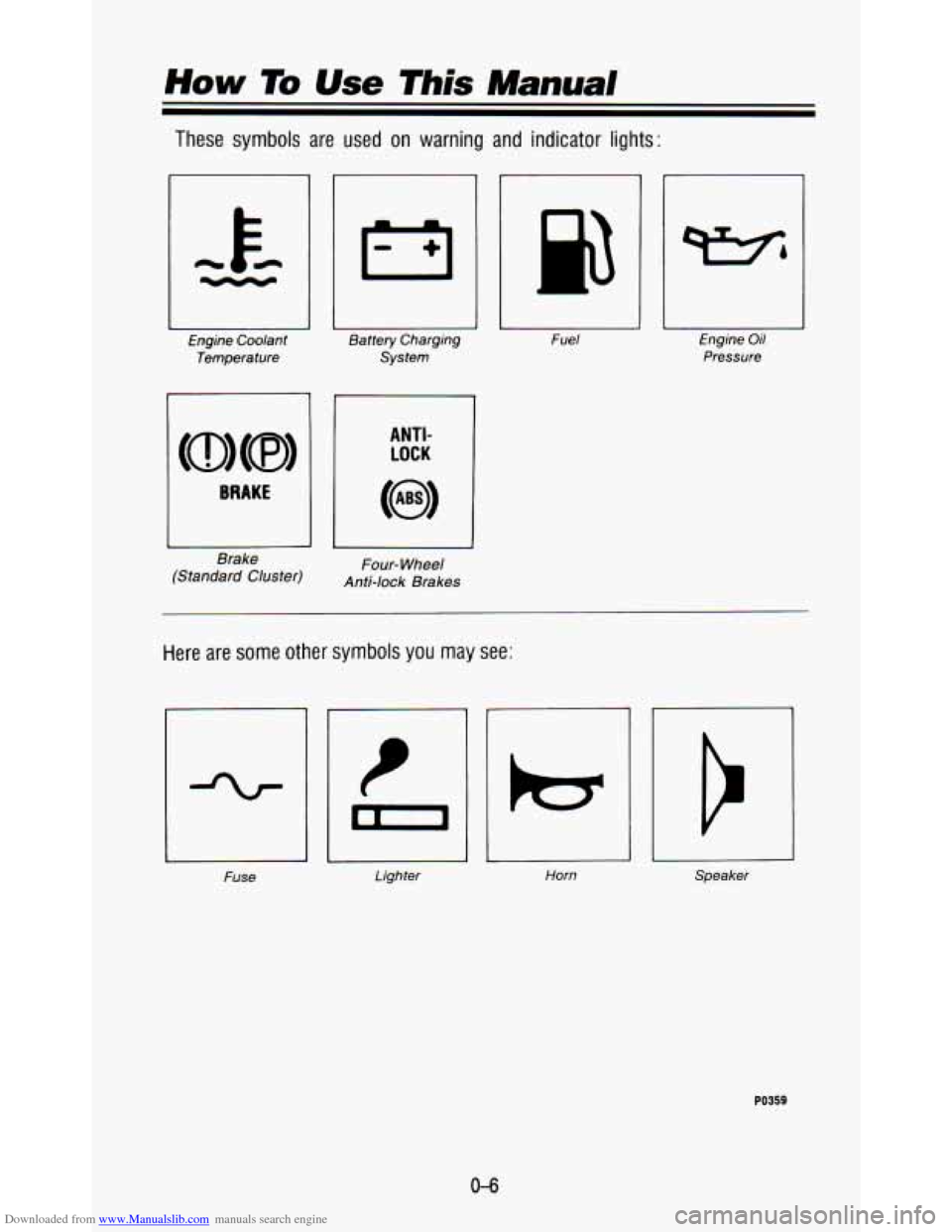
Downloaded from www.Manualslib.com manuals search engine These symbols are used on warning and indicator lights:
Engine Coolant
Temperature
BRAKE
Brake
(Standard Cluster) mrtery
Charging
System
I
ANTI-
LOCK
Four- Wheel
Anti-lock Brakes
Fuse Fuel
1
Engine Oil
Pressure
Here are some
other symbols you may see:
Lighter Horn Speaker
PO359
Page 26 of 345
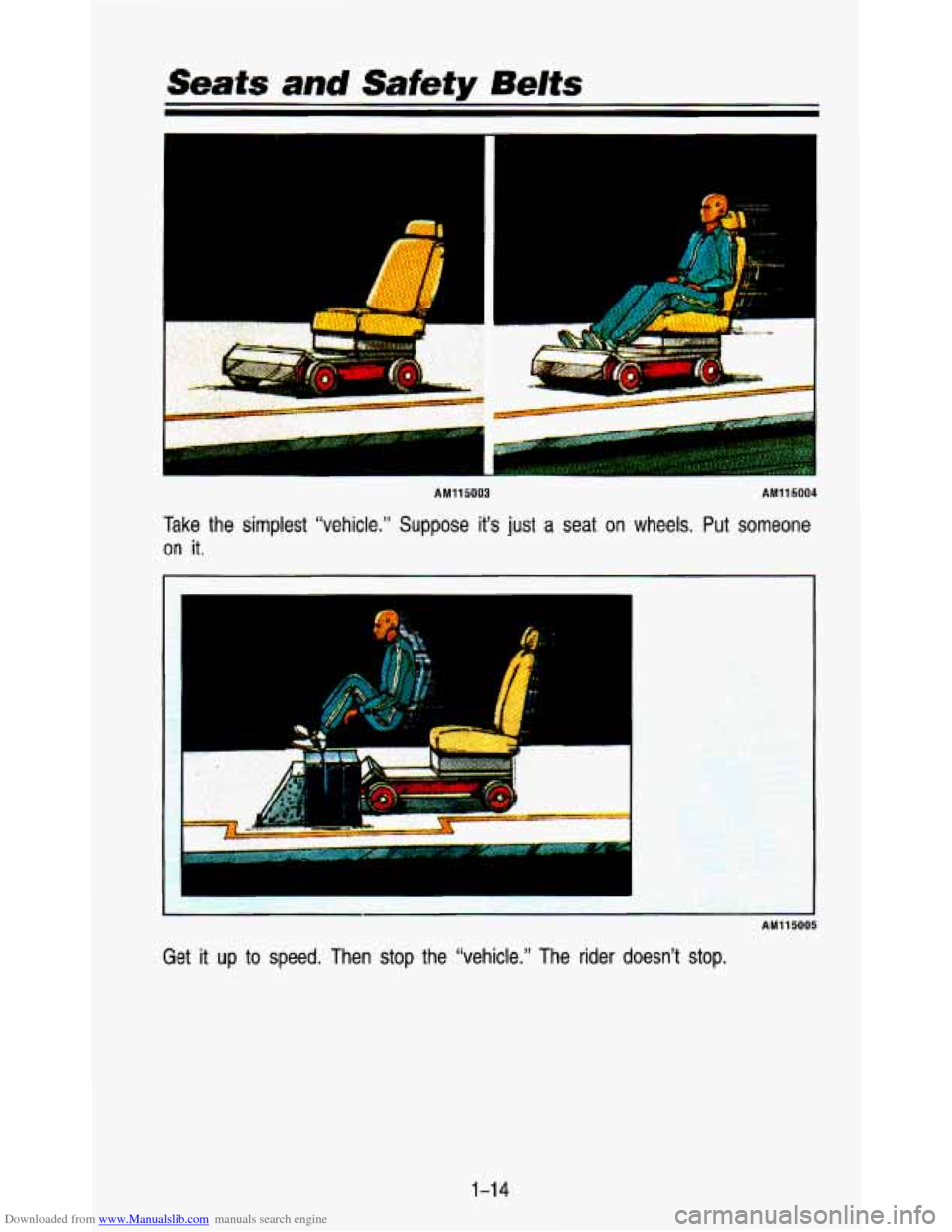
Downloaded from www.Manualslib.com manuals search engine Seats and Safety Belts
E
I R
AM115003 AM115004
Take the simplest “vehicle.” Suppose it’s just a seat on wheels. Put someone
on it.
I I
Get it up to speed. Then stop the “vehicle.” The rider doesn’\
t stop.
1-1 4
Page 58 of 345
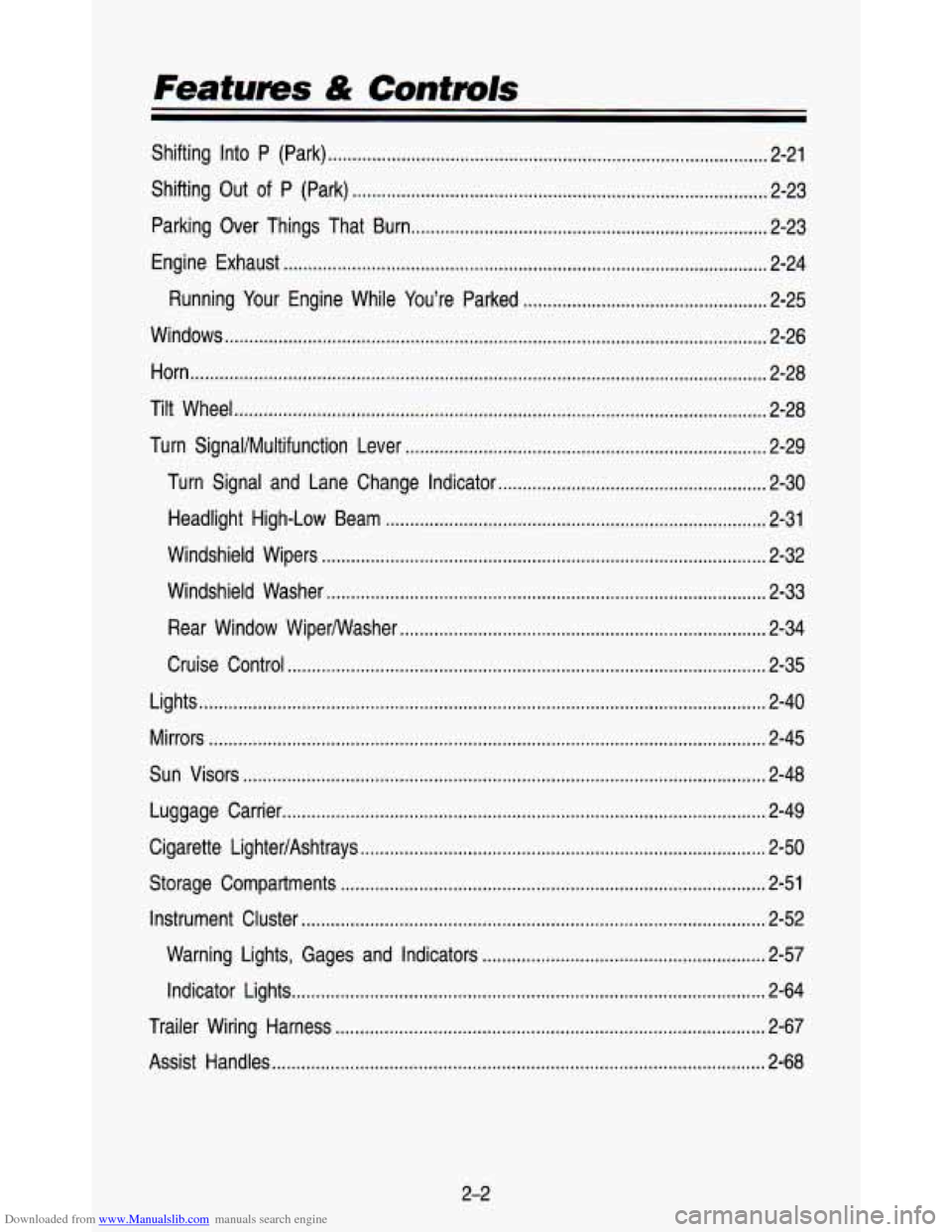
Downloaded from www.Manualslib.com manuals search engine Features & Controls
Shifting Into P (Park) ........................................................................\
.................. 2-21
Shifting Out
of P (Park) ........................................................................\
............. 2-23
Parking Over Things That Burn
........................................................................\
. 2-23
Engine Exhaust
........................................................................\
........................... 2-24
Running Your Engine While You’re Parked
.................................................. 2-25
Windows
........................................................................\
....................................... 2-26
Horn
........................................................................\
.............................................. 2-28
Tilt Wheel
........................................................................\
..................................... 2-28
Turn Signal/MuItifunction Lever
........................................................................\
.. 2-29
Turn Signal and Lane Change Indicator
....................................................... 2-30
Headlight High-Low Beam
........................................................................\
...... 2-31
Windshield Wipers
........................................................................\
................... 2-32
Windshield Washer
........................................................................\
.................. 2-33
Rear Window WiperNVasher
........................................................................\
... 2-34
Cruise Control
........................................................................\
.......................... 2-35
Lights
........................................................................\
............................................ 2-40
Mirrors
........................................................................\
.......................................... 2-45
Sun Visors
........................................................................\
................................... 2-48
Luggage Carrier
........................................................................\
........................... 2-49
Cigarette Lighter/Ashtrays
........................................................................\
........... 2-50
Storage Compartments
........................................................................\
............... 2-51
Instrument Cluster
........................................................................\
....................... 2-52
Warning Lights, Gages and Indicators
.......................................................... 2-57
Indicator Lights
........................................................................\
......................... 2-64
Trailer Wiring Harness
........................................................................\
................ 2-67
Assist Handles
........................................................................\
............................. 2-68
2-2
Page 68 of 345
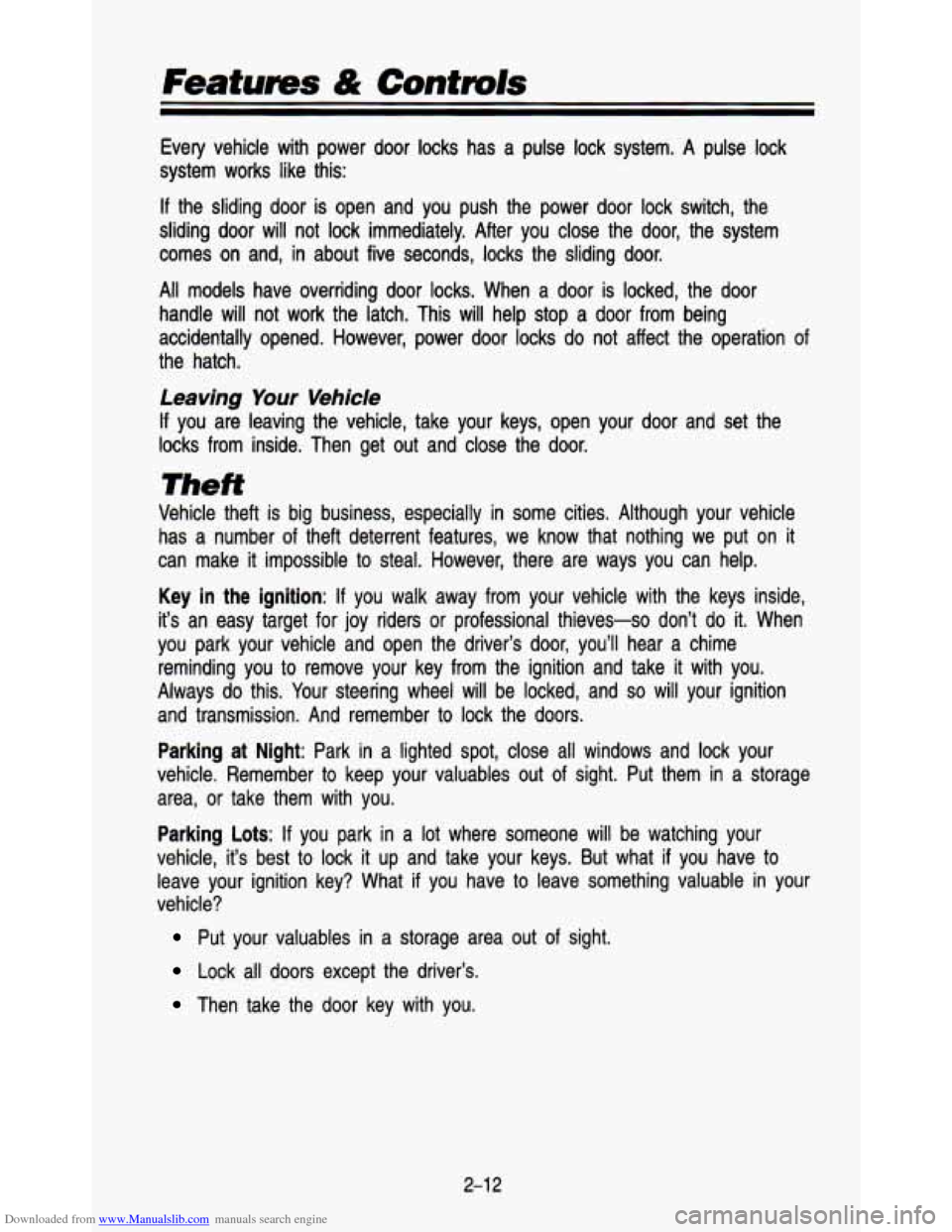
Downloaded from www.Manualslib.com manuals search engine Features & Contds
Every vehicle with power door locks has a pulse lock system. \
A pulse lock
system works like this:
If the sliding door is open and you push the power door lock sw\
itch, the
sliding door will not lock immediately. After you close the do\
or, the system
comes on and, in about five seconds, locks the sliding door.
All models have overriding door locks. When a door is locked, the \
door
handle will not work the latch. This will help stop a door from being
accidentally opened. However, power door locks do not affect th\
e operation of
the hatch.
Leaving Your Vehicle
If you are leaving the vehicle, take your keys, open your door and set t\
he
locks from inside. Then get out and close the door.
Theft
Vehicle theft is big business, especially in some cities. Although your vehicle
has a number of theft deterrent features, we know that nothing\
we put on it
can make
it impossible to steal. However, there are ways you can help.
Key in the ignition: If you walk away from your vehicle with the keys inside,
it’s an easy target for joy riders
or professional thieves-so don’t do it. When
you park your vehicle and open the driver’s door, you’ll \
hear a chime reminding you to remove your key from the ignition and take i\
t with you.
Always do this. Your steering wheel will be locked, and
so will your ignition
and transmission. And remember
to lock the doors.
Parking at Night: Park in a lighted spot, close all windows and lock your
vehicle. Remember to keep your valuables out of sight. Put the\
m in a storage
area,
or take them with you.
Parking Lots: If you park in a lot where someone will be watching your
vehicle,
it’s best to lock it up and take your keys. But what if you have to
leave your ignition key? What
if you have to leave something valuable in your
vehicle?
Put your valuables in a storage area out of sight.
Lock all doors except the driver’s.
Then take the door key with you.
2-1 2
Page 69 of 345
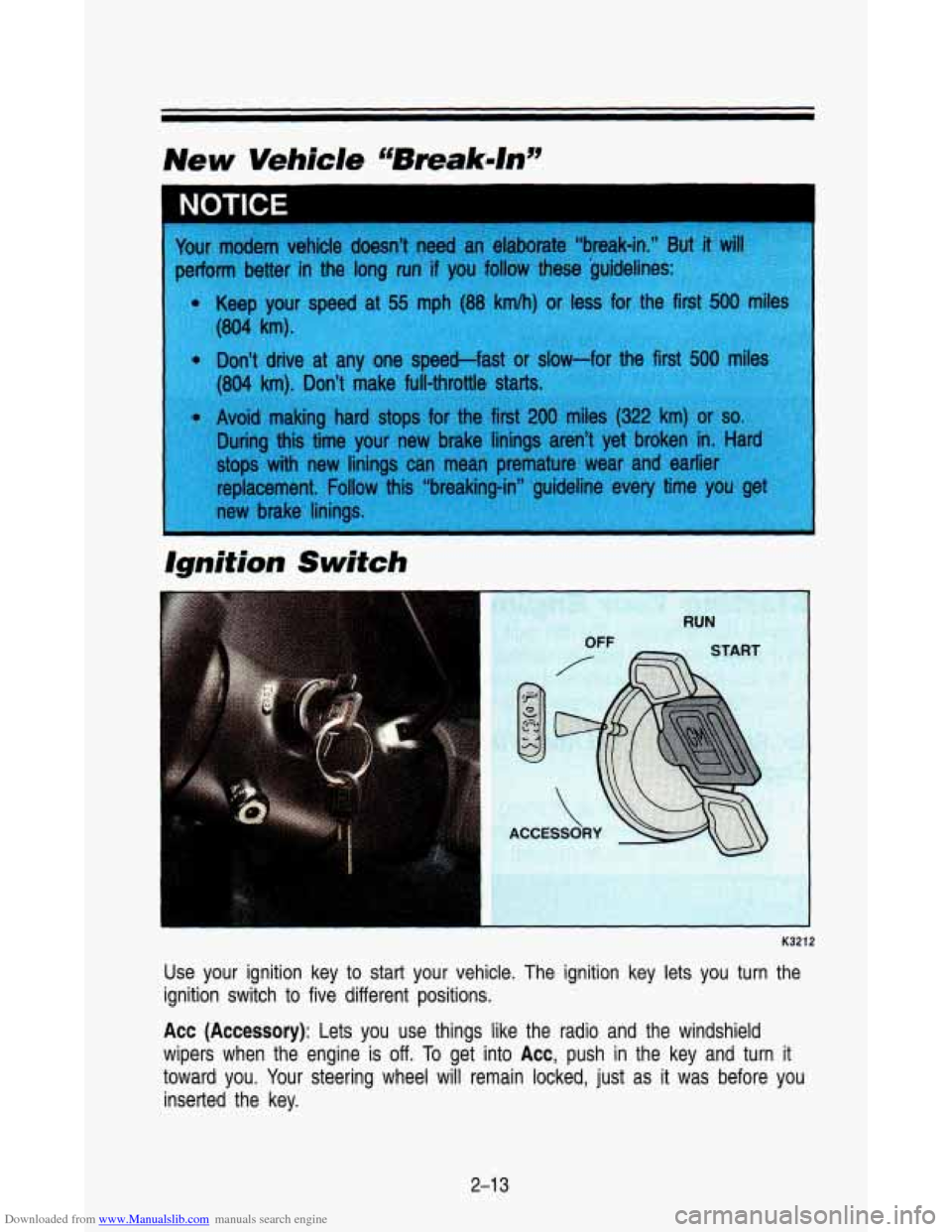
Downloaded from www.Manualslib.com manuals search engine I NOTICE
Ignition Switch
Use your ignition key to start your vehicle. The ignition key lets you turn the
ignition switch to five different positions.
Acc (Accessory): Lets you use things like the radio and the windshield
wipers when the engine is off. To get into
Acc, push in the key and turn it
toward you. Your steering wheel will remain locked, just as
it was before you
inserted the key.
2-1 3
Page 70 of 345
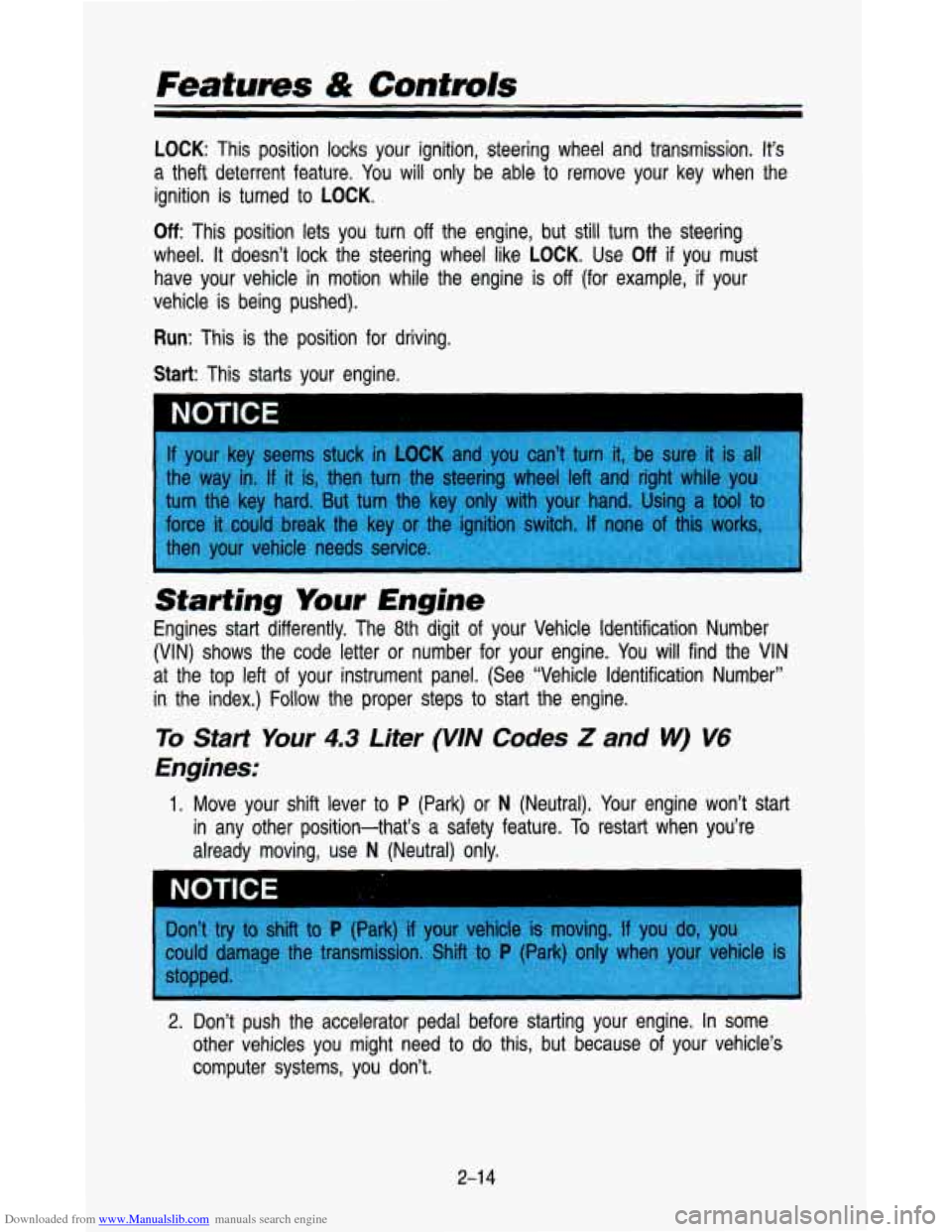
Downloaded from www.Manualslib.com manuals search engine LOCK: This position locks your ignition, steering wheel and transmissi\
on. It‘s
a theft deterrent feature. You will only be able to remove your key when the
ignition is turned to LOCK.
Off: This position lets you turn off the engine, but still turn the steering
wheel.
It doesn’t lock the steering wheel like LOCK. Use Off if you must
have your vehicle in motion while the engine is
off (for example, if your
vehicle is being pushed).
Ron: This is the position for driving.
Start: This starts your engine.
If your key seems stuck in LOCK and you can’t turn it, be sure it is ai
Starting Your Engine
Engines start differently. The 8th digit of your Vehicle Identification Number
(VIN) shows the code letter or number for your engine. You will find the VIN
at the top left of your instrument panel. (See “Vehicle Identification Number\
”
in the index.)
Follow the proper steps to start the engine.
To Start Your 4.3 Liter (WN Codes Z and W) V6
€nglnes:
1. Move your shift lever to P (Park) or N (Neutral). Your engine won’t start
in any other position-that’s a safety feature. To restart when you’re
already moving, use
N (Neutral) only.
2. Don’t push the accelerator pedal before starting your engine.\
In some
other vehicles you might need to
do this, but because of your vehicle’s
computer systems, you don’t.
2-1 4
Page 74 of 345
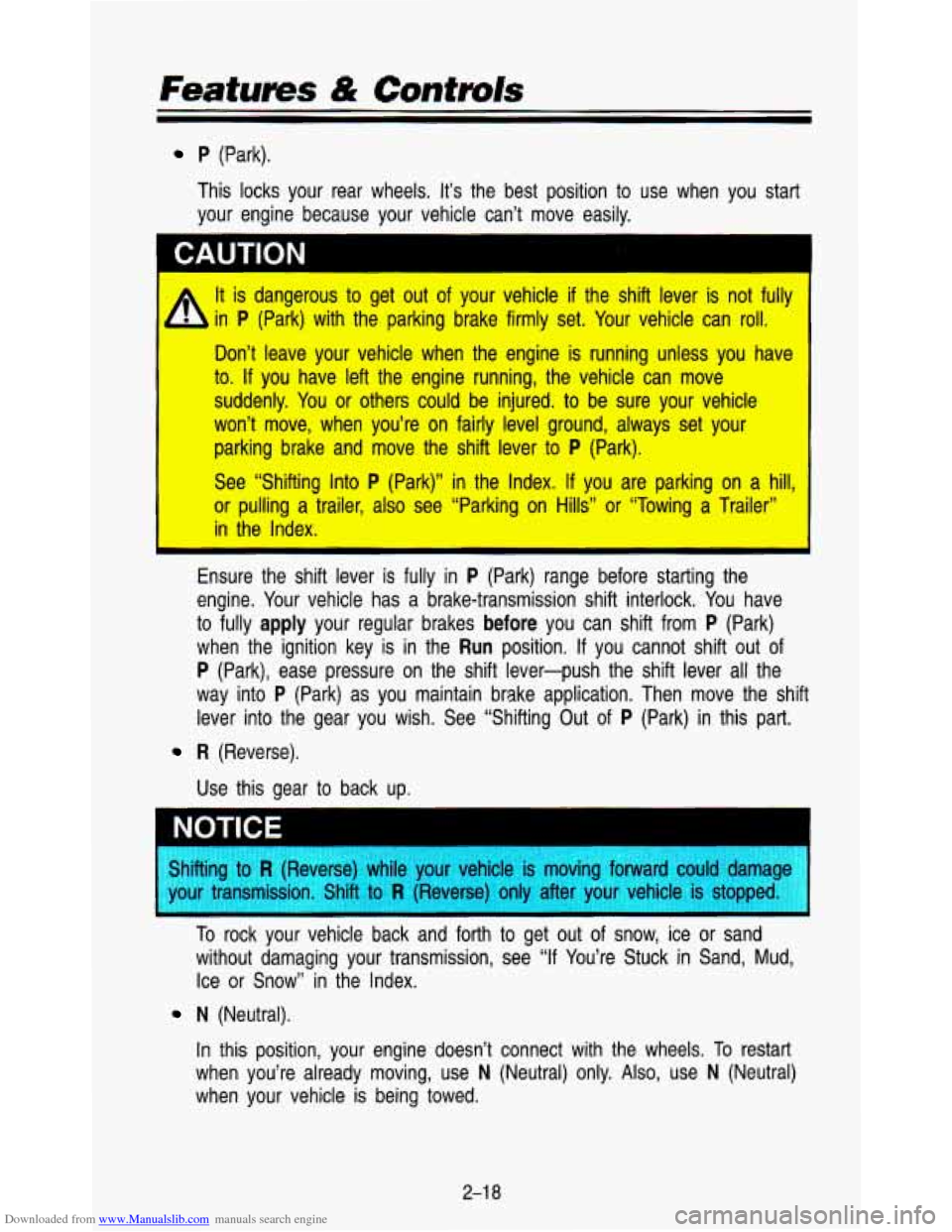
Downloaded from www.Manualslib.com manuals search engine P (Park).
This locks your rear wheels.
It’s the best position to use when you start
your engine because your vehicle can’t move easily.
WTION
It is dangerous to get out of your vehicle if the shift lever is not -fully
in
P (Park) with the parking brake firmly set. Your vehicle can roll. .
Don’t leave your vehicle when the engine is running unless you have
to.
If you have left the engine running, the vehicle can move
suddenly. You
or others could be injured. to be sure your vehicle
won’t move, when you’re on fairly level ground, always set your
parking brake and move the shift lever
to P (Park).
See “Shifting Into
P (Park)” in the Index. If you are parking on a hill:
or pulling a trailer, also see “Parking on Hills” or “Towing a Trailer”
in the Index.
Ensure the shift lever is fully in
P (Park) range before starting the
engine. Your vehicle has a brake-transmission shift interlock. You have
to fully
apply your regular brakes before you can shift from P (Park)
when the ignition key is in the
Run position. If you cannot shift out of
P (Park), ease pressure on the shift lever-push the shift lever\
all the
way into
P (Park) as you maintain brake application. Then move the shift\
lever into the gear you wish. See “Shifting Out of
P (Park) in this part.
R (Reverse).
Use this gear to back up.
I
Shifting to R (Reverse) while your vehicle is moving forward could dama--
your transmission. Shift
to R (Reverse) only after your vehicle is stoppec
To rock your vehicle back and forth to get out of snow, ice or sand
without damaging your transmission, see
“If You’re Stuck in Sand, Mud,
Ice or Snow” in the Index.
N (Neutral).
In this position, your engine doesn’t connect with the wheels.
To restart
when you’re already moving, use
N (Neutral) only. Also, use N (Neutral)
when your vehicle
is being towed.
2-1 8
Page 75 of 345
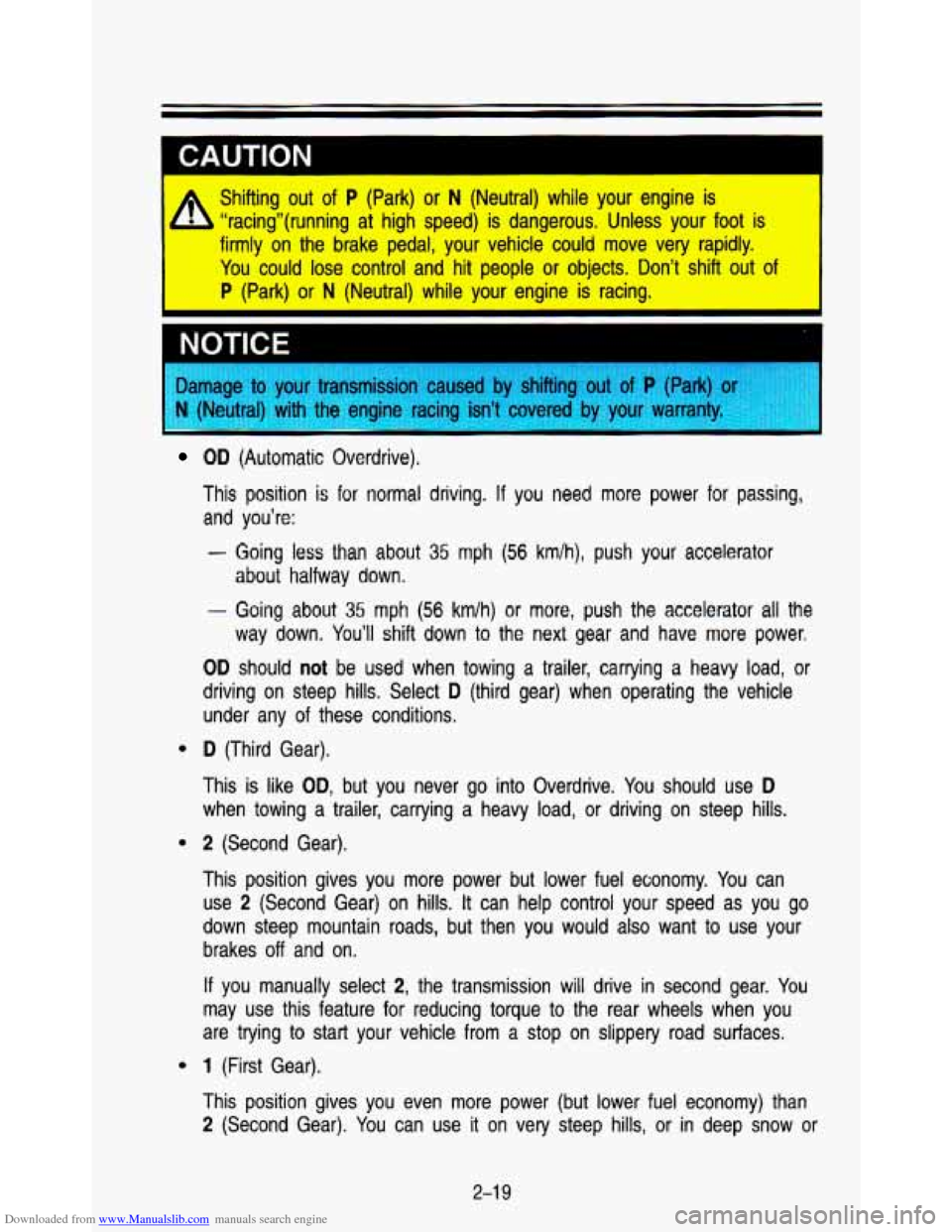
Downloaded from www.Manualslib.com manuals search engine CAUTION
Shifting out of P (Park) or N (Neutral) while your engine is
b “racing”(running at high speed) is dangerous. Unless your\
foot is
firmly on the brake pedal, your vehicle could move very rapidl\
y.
You could lose control and hit people or objects. Don’t shift out
of
P (Park) or N (Neutral) while your engine is racing.
NOTICE
sed by shifting out of P (Park) (
g isn’t covered I . .. . . . . . by . , . ..I. your , , , , warranty. , ., , ; s,L ., ... . , I . ::: :,.:. ’ .. ’., ; , : , .. . .: .. . , .. , , , . . . , .,
e
e
e
OD (Automatic Overdrive).
This position is for normal driving. If you need more power for passing,
and you’re:
- Going less than about 35 mph (56 km/h), push your accelerator
about halfway down,
- Going about 35 mph (56 km/h) or more, push the accelerator all the
way down. You’ll shift down to the next gear and have more power.
OD should not be used when towing a trailer, carrying a heavy load, or
driving on steep hills. Select
D (third gear) when operating the vehicle
under any of these conditions.
D (Third Gear).
This
is like OD, but you never go into Overdrive. You should use D
when towing a trailer, carrying a heavy load, or driving on steep hills.
2 (Second Gear).
This position gives you more power but lower fuel economy. You can
use
2 (Second Gear) on hills. It can help control your speed as you go
down steep mountain roads, but then you would also want to use your
brakes
off and on.
If you manually select 2, the transmission will drive in second gear. You
may use this feature
for reducing torque to the rear wheels when you
are trying to start your vehicle from
a stop on slippery road surfaces.
1 (First Gear).
This position gives you even more power (but lower fuel econo\
my) than
2 (Second Gear). You can use it on very steep hills, or in deep snow or
2-1 9
Page 76 of 345
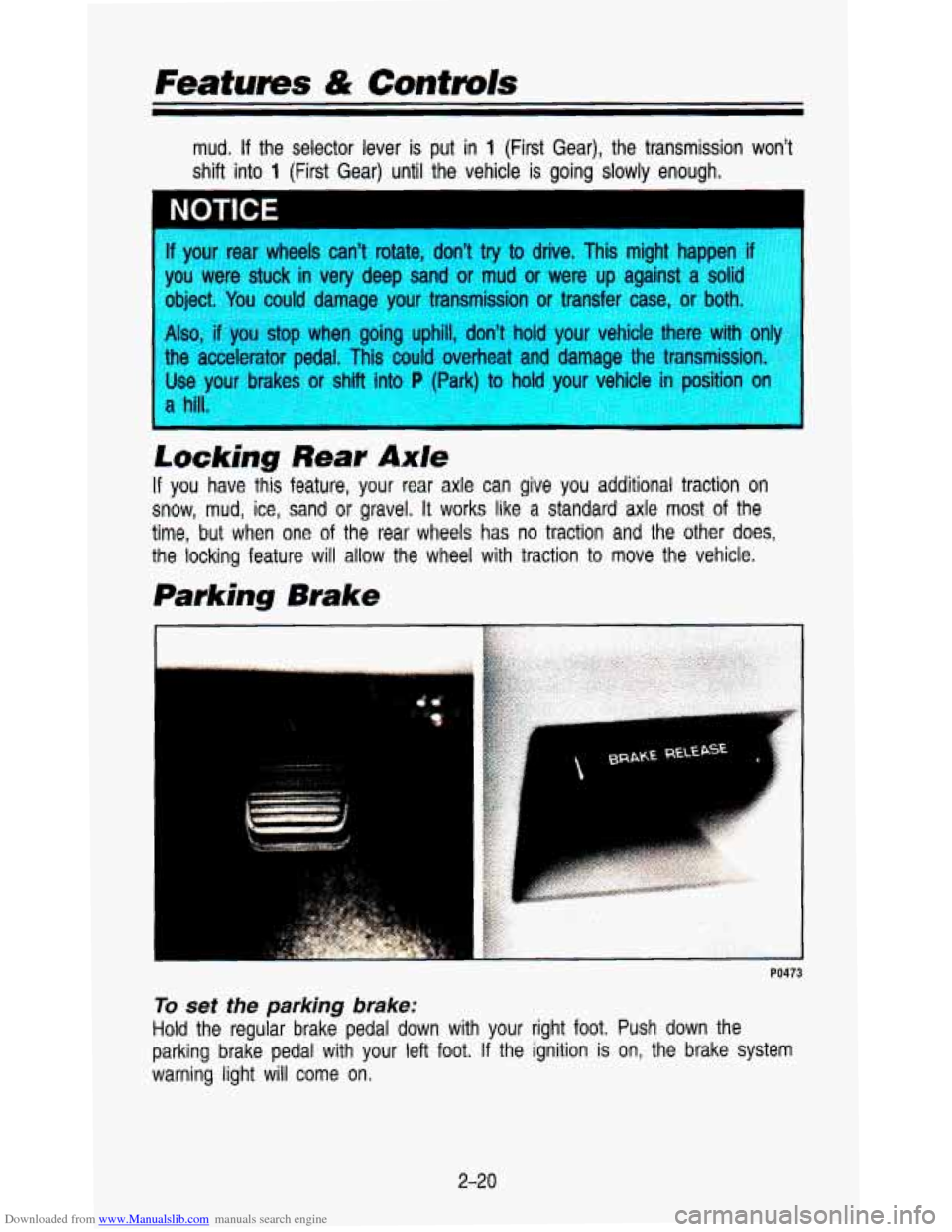
Downloaded from www.Manualslib.com manuals search engine Features & Controls
mud. If the selector lever is put in 1 (First Gear), the transmission won't
shift into
1 (First Gear) until the vehicle is going slowly enough.
NOTICE 1
I
If your rear wheels can't rotate, don't try to drive. This might happen
you were stuck in very deep sand
or mud or were up against a soli(
obiect. You could damage your transmission or transfar case, or hoth
Atso, IT u stop when goir uphill, m't hold your vel ~ -e tl 'e with only
the accelerator pedal. This could overheat and damage the transmission.
Use yo1 "--kes or shift into :Park) hold your vehicle in position o
Loc&hg Rear Axle
If you have this feature, your rear axle can give you additional traction on
snow, mud, ice, sand or gravel. It works like a standard axle most of the
time,
but when one of the rear wheels has no traction and the other does,
the locking feature will allow the wheel with traction to move\
the vehicle.
Parking Brake
2-20
Page 77 of 345
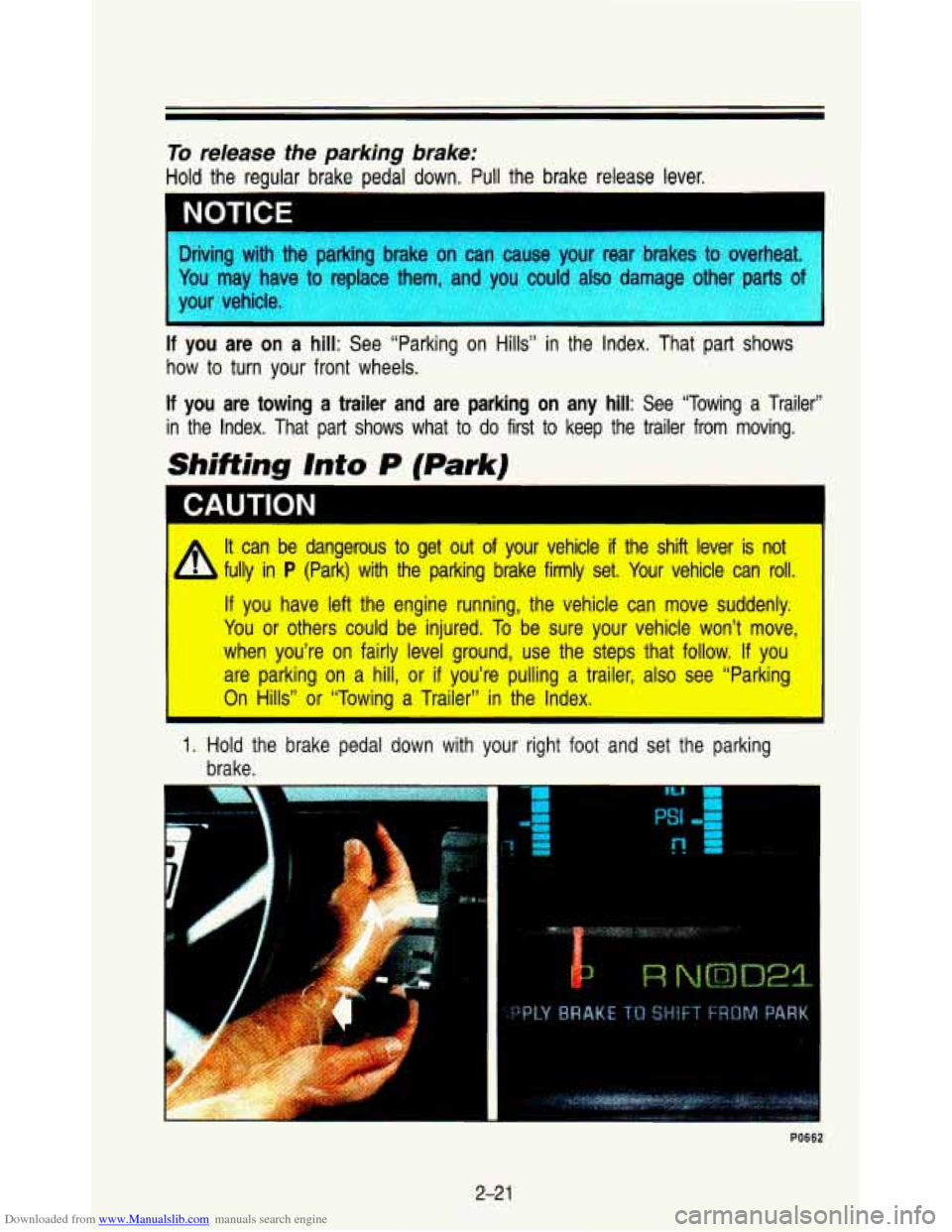
Downloaded from www.Manualslib.com manuals search engine To release the parking brake:
Hold the regular brake pedal down. Pull the brake release lever.
I NOTICE -1
, ,arking brakL
in ronlnro thorn ar
hiving .Ah thc , ,Pwe your real ,rakes to nverheal.
‘ou may ha
‘our vehicle.
- -
If you are on a hill: See “Parking on Hills” in the Index. That part shows
how to turn your front wheels.
If you are towing a trailer and are parking on any hill: See “Towing a Trailer”
in the Index. That part shows what to do first to keep the \
trailer from moving.
Shifting Into P (Park)
A It can be dangerous’to get out of your vehicle if the shift lever is not
b fully in P (Park) with the parking brake firmly set. Your vehicle can roll.
If you have left the-engine running, the vehicle can move suddenly.
You or others
could be injured. To be sure your vehicle won’t-:.rnove,
when you’re on
faiily level ground, use the steps that follow. If you
are parking
on $:hi!!, or if you’re pulling’ a trailer, also see “P;a.rking
On Hills” or “Towing a Trailer” in the Index.
1. Hold the brake pedal down with your right foot and set the parking\
brake.
F“
2-2 1